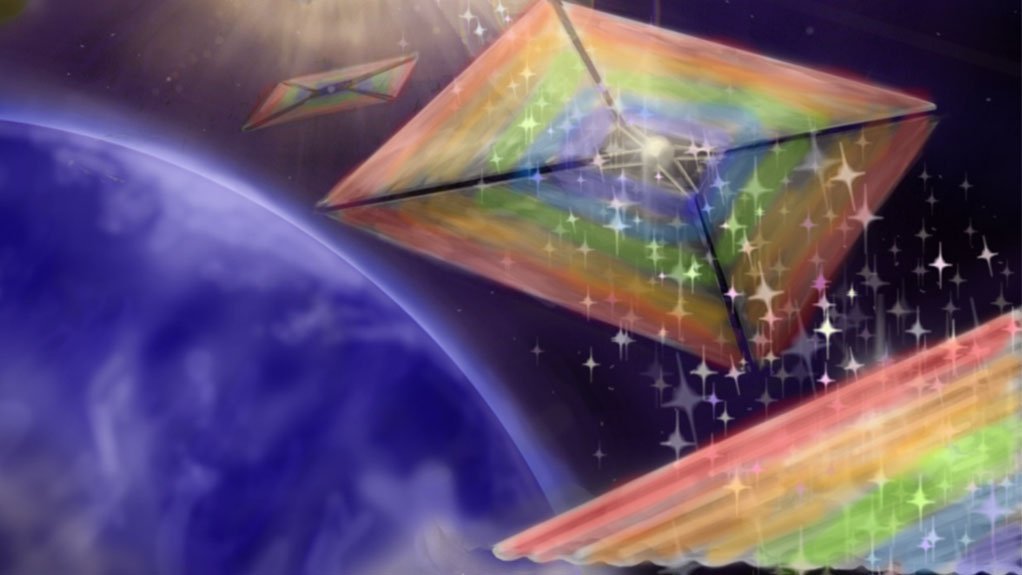Nasa funding the further development of advanced solar sail concept for space propulsion
The US space agency, the National Aeronautics and Space Administration (Nasa), has awarded funding of $2-million, over two years, for the further development of an advanced solar sail concept, to take it towards a demonstration mission. Solar sails use the pressure exerted by the light of the Sun as a source of propulsion, analogous to how sailing ships on Earth use winds to navigate the seas.
The money has been granted under Phase III of the Nasa Innovative Advanced Concepts (NIAC) programme. “The [NIAC] helps to unlock visionary ideas – like novel solar sails – and bring them closer to reality,” highlighted Nasa administrator Bill Nelson.
Hitherto, the idea of solar sailing has been the deployment, in space of course, of a very large and very thin sheet (or sheets) of material, which catch (and reflect) sunlight, thereby achieving propulsive power. This was first successfully demonstrated by the Japan Aerospace Exploration Agency’s Ikaros technology demonstrator interplanetary spacecraft; launched in mid-2010, it flew by Venus near the end of that year and then entered an orbit around the Sun.
The drawback of ‘conventional’ solar sailing such as used by Ikaros is that the navigational course options for the spacecraft are limited by the direction of the sunlight. Courses that seek to deviate from the direction of the sunlight suffer from a loss of propulsive power. Mission planners are forced to make trade-offs between power and navigation.
The new concept is known as ‘diffractive solar sailing’. A diffractive solar sail will have sails composed of small gratings embedded in thin films. Diffraction is a property of light: when it passes through a narrow opening, it spreads out. A diffractive solar sail would allow much greater manoeuvrability without suffering significant power loss.
The Phase III NIAC funding will allow the optimisation of the sail material and allow the execution of ground tests. Under NIAC Phase I and Phase II funding, different types of diffractive sail material were designed, made and tested; new navigation and control concepts for a potential mission to orbit the Sun’s poles were designed; and various experiments were conducted.
Diffractive solar sailing would be especially useful in placing spacecraft in polar orbits around the Sun. Such orbits are difficult to reach with conventional propulsion systems.
“Diffractive solar sailing is a modern take on the decades-old vision of lightsails,” pointed out Johns Hopkins University Applied Physics Laboratory researcher and diffractive solar sailing project leader Amber Dubill. “While this technology can improve a multitude of mission architectures, it is poised to highly impact the heliophysics [Sun physics] community’s need for unique solar observation capabilities. With our team’s combined expertise in optics, aerospace, traditional solar sailing, and metamaterials, we hope to allow scientists to see the Sun as never before.”
Comments
Press Office
Announcements
What's On
Subscribe to improve your user experience...
Option 1 (equivalent of R125 a month):
Receive a weekly copy of Creamer Media's Engineering News & Mining Weekly magazine
(print copy for those in South Africa and e-magazine for those outside of South Africa)
Receive daily email newsletters
Access to full search results
Access archive of magazine back copies
Access to Projects in Progress
Access to ONE Research Report of your choice in PDF format
Option 2 (equivalent of R375 a month):
All benefits from Option 1
PLUS
Access to Creamer Media's Research Channel Africa for ALL Research Reports, in PDF format, on various industrial and mining sectors
including Electricity; Water; Energy Transition; Hydrogen; Roads, Rail and Ports; Coal; Gold; Platinum; Battery Metals; etc.
Already a subscriber?
Forgotten your password?
Receive weekly copy of Creamer Media's Engineering News & Mining Weekly magazine (print copy for those in South Africa and e-magazine for those outside of South Africa)
➕
Recieve daily email newsletters
➕
Access to full search results
➕
Access archive of magazine back copies
➕
Access to Projects in Progress
➕
Access to ONE Research Report of your choice in PDF format
RESEARCH CHANNEL AFRICA
R4500 (equivalent of R375 a month)
SUBSCRIBEAll benefits from Option 1
➕
Access to Creamer Media's Research Channel Africa for ALL Research Reports on various industrial and mining sectors, in PDF format, including on:
Electricity
➕
Water
➕
Energy Transition
➕
Hydrogen
➕
Roads, Rail and Ports
➕
Coal
➕
Gold
➕
Platinum
➕
Battery Metals
➕
etc.
Receive all benefits from Option 1 or Option 2 delivered to numerous people at your company
➕
Multiple User names and Passwords for simultaneous log-ins
➕
Intranet integration access to all in your organisation





















